Types of Chatbots: An Overview for Business People

In the effort to automate as many processes as possible, companies resort to various solutions powered by modern technology. We’ve written about Enterprise Resource Planning systems and automated contact centers lately. Internet bots, or simply bots, may be the best-known form of automation in customer communications.
Gartner once predicted that by 2020, more than 50% of medium to large enterprises would have deployed product chatbots. By 2021, over 50% should be spending more on creating various types of bots than traditional mobile app development.
(We should clarify one thing now. We understand chatbots as programs which carry on conversations with humans by automatically engaging with received messages. The terms may be used interchangeably, but chatbots are in fact a category in a rather arbitrary classification of bots. Along with search engine spiders, transactional bots in the area of robotic business process automation, video game bots, and other helpful applications, chatbots can be classified as ‘good bots.’ Forum and comment spammers, hacker bots, scrapers, Twitter impersonators, and similar social bots are naturally ‘bad/malicious.’)
As chatbot developers, we are primarily interested in raising awareness of helpful bots. The first chapter of this post is classifying them by different criteria. The second offers advice to business people that wish to employ chatbot technology for different purposes.
Types of Chatbots Classified by…
Deployment/Medium
The easiest classification is to divide chatbots into:
1. bots integrated within social media and messaging apps like Facebook Messenger, Slack, Telegram, Twitter, WhatsApp, etc.;
2. standalone applications (e.g., Amazon Alexa, Google Assistant or Siri).
Standalone chatbots may leverage various mediums to receive and respond to messages, such as voice, SMS, or website chat windows.
Social messaging chatbots need not be installed separately and are easy to access. They also feel natural for app users: they interact with the bot like with their friends. Additionally, bot owners take the instant advantage of the messengers’ impressive adoption rate.

Expertise
It’s pretty simple to distinguish between generalist and specialist bots. Alexa, Google Assistant, Cortana, and Siri belong to the first class. Generalist chatbots can understand what a user is asking but usually can’t complete a task on their own. Often, the interaction starting with “OK Google” is only the first step in a process. The chatbot would route the request, but subsequent steps will depend on specialist bots that ‘do the job’ for the user. They possess the domain-specific expertise necessary to accomplish tasks.
Another common sense rule is that digital giants mostly build generalist bots. Enterprises and individual chatbot developers concentrate on a specific job-to-be-done. For example, 1-800-Flowers chatbot was one of the first available on the Messenger platform. It enabled customers to order flowers or speak with support. In June 2016, soon after launch, 70% of customers ordering through the chatbot were reportedly new customers. It’s predicted that companies will be increasingly looking to develop their own specialist bots to improve communication and increase productivity.
Purpose
From a business perspective, the programs should fall into three most common groups:
1. Support/action chatbots
Such bots should master a single domain, e.g., know everything about a company, so that they can walk users through any business process or answer various questions. Support chatbots must be easy to navigate, fast in completing tasks, as well as possess a personality, multi-turn capability, and context awareness. Speech is an optional feature.
Such chatbots have the ability to simplify the way businesses interact with customers. 24×7 customer service is probably the most appropriate application for them in any industry. The bots help automate frequently asked questions and can differentiate between the issues they can manage and questions they should refer to a human.
The function is not limited to customer support, however. For example, the Messenger chatbot of the travel search engine Hipmunk promises to answer questions, search for flights and hotels, and provide recommendations to travelers. In its welcome message, Hipmunk suggests that customers should start by indicating their location. Action chatbots may be asking for relevant data from the user to take action or complete a task, e.g., check flight status, book cost, etc.
In the case of e-commerce, support/action chatbots can help businesses by:
- adding interactivity
- building customer relationships on a more personal level
- solving the abandoned cart issue
- substituting for emails
- managing sales funnels
2. Skills chatbots
These are typically more single-turn-type bots. They have set commands like “Open the garage door” or “Play me the song of an acorn woodpecker,” which they should perform quickly. Custom Alexa skills are an obvious example.
Speech functionality is desirable for this type of applications, so there’s no need to press any buttons. It’s also important to focus on integration, especially when controlling smart home devices. Conversely, contextual awareness can be limited, unless you need a particularly advanced assistant.
3. Assistant chatbots
Assistants are a middle ground between the above types of chatbots. They can respond to questions on any topic and are conversational and entertaining. Siri is a great example. Such bots may eventually become powerful marketing platforms and navigators of all other bots that are currently out there.
Bot Intelligence
Programmers also differentiate bots that are built with and without machine learning (ML) and artificial intelligence (AI). Basically, some bots learn, and some don’t (that much). We can distinguish two groups based on the bot intelligence:
1) Scripted chatbots
These are also called quick reply bots. They are designed to respond to specific commands and answer specifically phrased questions. The interaction is based on a “script” which determines what can and can’t be done. The script is either a set of questions which a user is anticipated to ask or a rule-based model where each action by the user triggers an action or response by the chatbot. Often, the user doesn’t even have to type anything in, selecting from an available list of questions or commands instead.
The bot’s domain is necessarily limited, e.g., for a customer service chatbot. It might feel restrictive, but by being explicit about the limits of the bot’s domain and grammar of acceptable responses, you can keep the interaction directed and the quality of the user experience pretty high. When users go off the script, the bot can always transfer the communication to a human customer service agent.
Scripted bots are the simplest, cheapest, and the businesses’ likeliest first choice. A brand chatbot on a messaging app can be limited in its capabilities but still communicate with personality and style. A single chatbot can seamlessly blend the brand marketing discourse with fun content and helpful service. It can successfully engage people into the brand, create an element of interactive communication, and even upsell and cross-sell to customers.
Still, some scenarios require more advanced bots. They can be programmed to respond the same way each time, to react differently to messages containing specific keywords, and even to adapt their responses to the situation. Some script bots use Natural Language Processing — an AI technology — on the front end of the interaction. NLP allows mapping user’s text or voice to an intent by parsing out words that may match an answer in the script.
2) Smart bots
A robust server-side processing component allows these bots to access to massive computing power in understanding and responding to queries. It’s often combined with the open-sourcing of ML libraries like TensorFlow.
Chatbots using ML can understand questions and commands the way people phrase them and can learn and develop over time. Elements of ML and AI are required if they have to process complex requests and manage dynamic outputs. This is beneficial if you’re looking to offer a human-like experience. However, smart bots need not necessarily be that ‘smart.’ Sometimes, an ML-powered application’s only task is to recognize the breeds of dogs in photos.
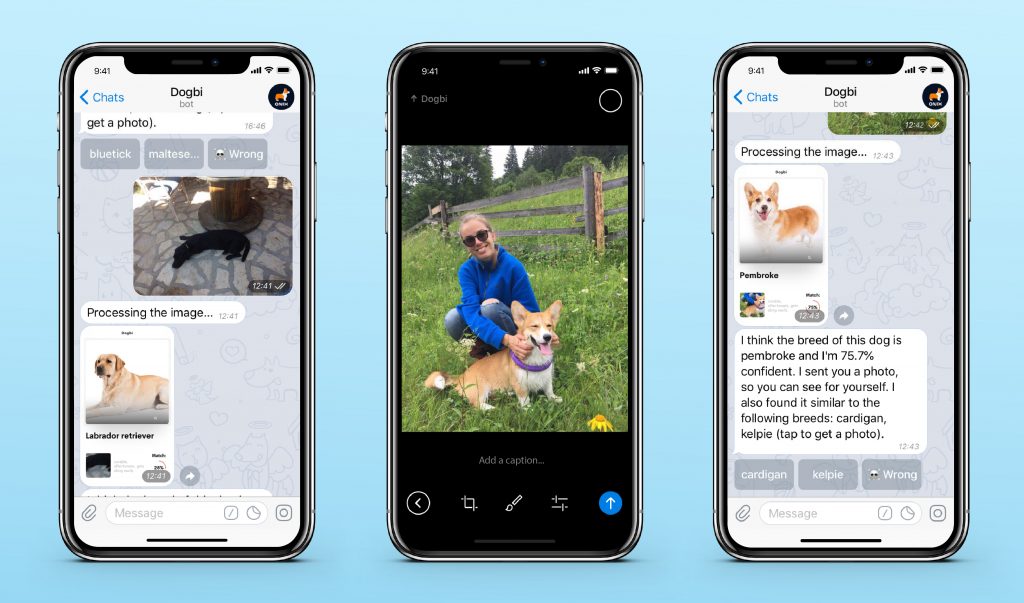
Many chatbots leverage AI for the first response mechanism. If the interaction takes a turn that the AI can’t handle, the system falls back on a human agent to sort things out. The “AI + Human Agent” model is also suitable for customer service applications.
Complexity
The quality of user experience delivered by a bot often correlates with its technical complexity and ability to leverage conversation contexts. In this aspect, chatbots come in three distinct flavors.
1) Menu/button-based chatbots
This is the most basic type today, largely coinciding with the scripted bots category. In most cases, these chatbots are decision trees presented to the user in the form of quick reply buttons, very similar to the automated phone menus. Each response/selected button takes the user down a specific path, which opens up a predetermined set of possibilities towards the ultimate answer or task.
These applications are sufficient for guiding new users or answering the FAQs that make up 80% of support queries. They’re also pretty efficient for on-demand services. For example, messenger bots designed by Domino’s Pizza and Pizza Hut are presenting information about the latest promotions and allowing customers to place orders with a single tap.
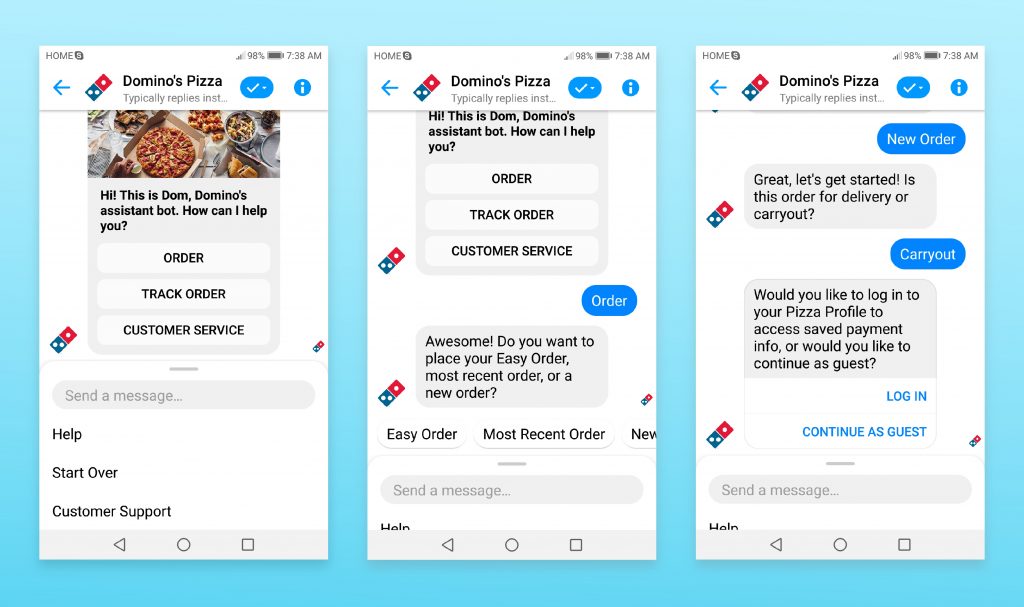
However, menu-based chatbots are not suitable for more advanced scenarios in which there are too many variables, or it’s too difficult to predict how users should get to specific answers.
2) Keyword recognition-based chatbots
These bots can listen to what users say or type. They utilize customizable keywords and AI to determine how to respond appropriately.
It is becoming popular to build chatbots that are both keyword recognition- and button-based. The users can first try to ask their questions directly. If the result is inadequate or the user requires some guidance, they can use the chatbot’s menu buttons.
3) Contextual chatbots
These are the most advanced of the three types of chatbots. Alexa, Google Assistant, and Siri are some of the examples of context-enabled chatbots. They utilize ML and AI to remember conversations with specific users to learn over time. They’re smart enough to learn from past experiences, i.e. what users are asking for, how they’re asking it, and so on.
For example, a contextual chatbot for pizza orders will store a customer’s data from each conversation. When the customer uses the application next time, it will recall their most common order, delivery address, and payment information. Then, the bot will ask if the customer would like to repeat the order. Instead of typing and having to respond to many questions, the customer just has to answer with ‘Yes.’
Chatbot Technology
Technology-wise, there are two types of chatbots:
1. drag-and-drop / do-it-yourself bots;
2. code-based chatbots.
Drag-and-drop bots are created with the help of bot building platforms, e.g., Chatfuel, Chattypeople, Motion.ai, etc., and other broadly accessible tools. There are usually off-the-shelf templates suitable for specific businesses (e.g., customer support, e-commerce, surveys, etc.). Even non-technical users can build a chatbot with a predefined functionality and only add the features they need. It’s a piece of cake in the case of Alexa skills: Blueprints service lets ordinary users endow their Echo devices with unique abilities without any programming.
Code-based bots typically include a built-in AI technology and are made using software frameworks like Facebook Bot Engine with Wi.ai NLP service or Microsoft Bot Frameworkwith luis.ai NLP service. These tools work well for basic customer engagement requirements but may fall short for over-the-top functionalities integration. In such cases, businesses should seek custom chatbot development services.
Which Type Is Right for Your Business?
Businesses can make the most of any type of bots regardless of the industry. However, the individual choice of the chatbot type, technology, and programming depends a lot upon:
1. the business needs;
2. unique value proposition;
3. the customer base to serve.
Do some research at the onset. Talk with your social media and sales personnel. Are there any customer service issues? Do you need to promote a new product? If your team can’t keep up with the number of messages on some social channels, try to leverage messenger bots. Smart and scripted chatbots can assist with 24/7 support, provide new marketing channels, and help automate your social media marketing.
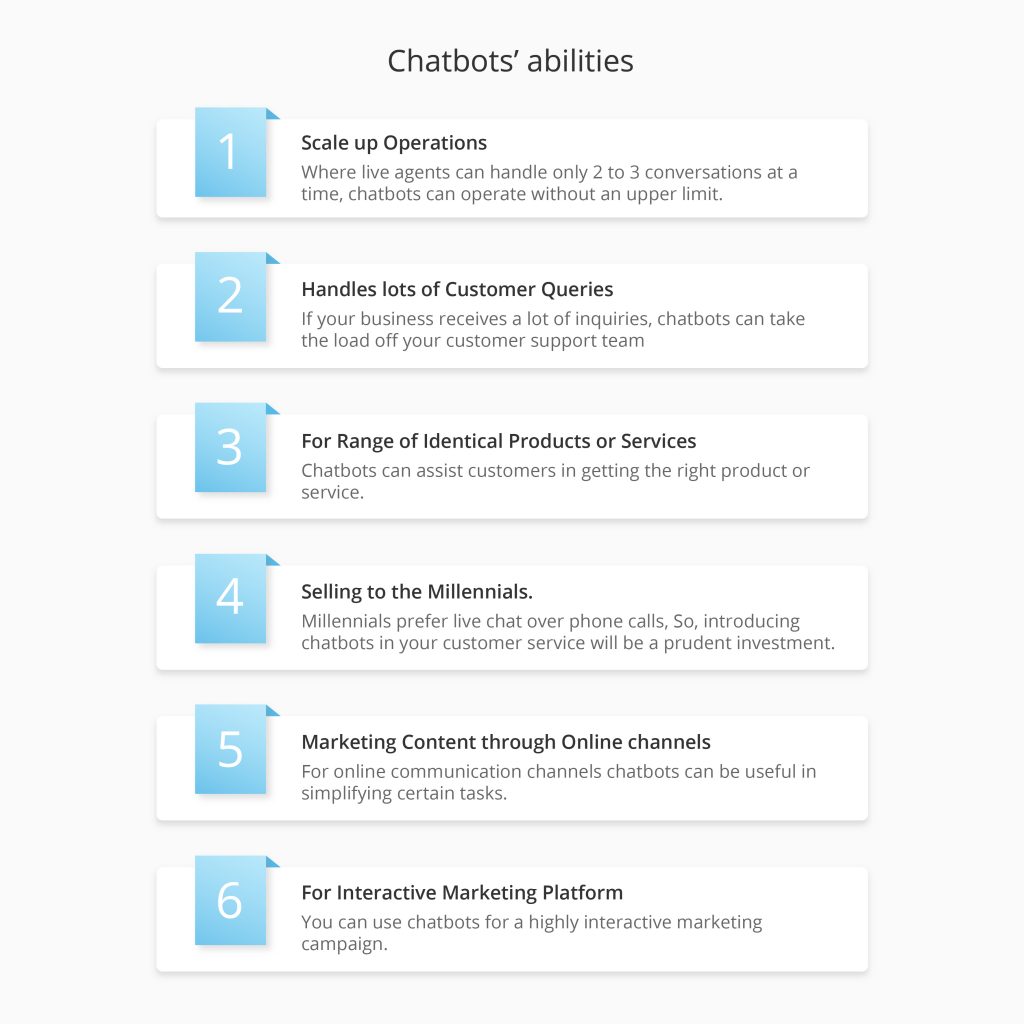
If your business website experiences low conversion rates, it’s high time to implement a website bot. It helps to provide 24/7 response times to visitors. Always having a virtual assistant “on call” to answer questions and book meetings with prospects, a business can improve lead generation with a small team or none at all.
Most importantly, modern chatbots facilitate reaching your customers. Sales and marketing teams can use them to trigger conversations with prospects when they need assistance the most. The bots know when a visitor opens a sales email and then visits a landing page. Website chatbots can assist with demos or booking meetings with salespeople, pushing prospects further down the funnel with engaging content, and other tasks. During the interactions, companies can collect key information like the prospect’s name, email address, and phone number for follow-ups.
In the B2B sales/buying process, website bots have the ability to reduce friction and replace some of the typical steps. That results in higher sales velocity and more closed deals.
Regardless of the type, every business chatbot should fit the value proposition you’re trying to convey to your users. Think carefully about what problems you should solve for them. That’ll determine what functionality you have to incorporate into your chatbot.
The most popular use of scripted chatbots is to provide quick answers in an emergency. They also help decrease the average time to respond, feed valuable information to customers, or enable commercial transactions when your business is closed. Chatbot-based customer service is best to apply in the banking and finance services, travel, hospitality and tourism industries, healthcare, and on-demand services.
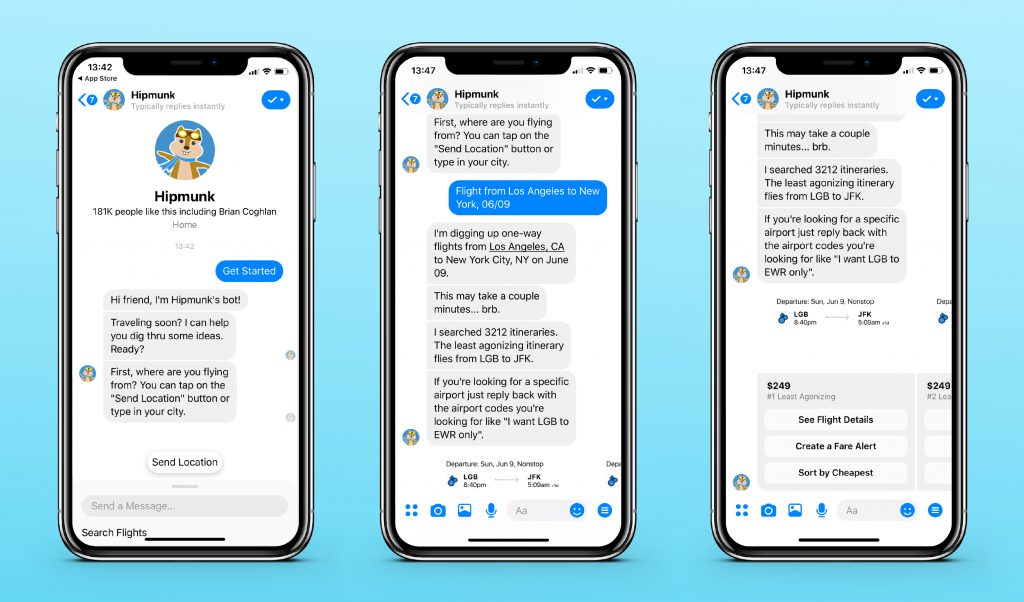
Businesses that need the capabilities for the maximum number of customers should opt for messenger bots. Social networks and messengers have enormous numbers of active users. That will also help your brand sooner receive the recognition it deserves and unlock new marketing channels.
Messenger bots help create delightful, interactive brand experiences. On Facebook Messenger, they automate the provision of information and product recommendations to customers, customer data collection, taking orders, and much more. A Twitter chatbot for Direct Messages may complement a socially-driven marketing campaign or customer service.
It would be best if you were supporting several messenger bots simultaneously. However, it’s essential to engage with customers where they are. Start with the platform that is most popular in your area or with your target group.
Place yourself in the shoes of the end-users. What value are they trying to receive? Will the conversation context be important? For example, visitors on your homepage must be more knowledgeable of your value proposition than those who got to a blog post. Think about people using mobile phones. The social networks’ demographics also differ. Your customers on Facebook might have different questions than Slack users. Ideally, the conversations on the web pages, networks, or other channels your bots live on should also differ.
The preferences of your target audience is another thing to consider when choosing the type of chatbot and platform. For example, some people like to be guided with visual menu buttons rather than to ask open-ended questions.
User awareness will impact both your development plan and the user experience design. In some cases, it would require enterprise-level AI capabilities, but most often, that’s overkill for the needs of end-users and the value proposition. It’s best to start with simple menu buttons and intuitive, rules-based conversational workflows.
No matter what type of bot you decide to build, it’s crucial to make it helpful and easy to use. Test your chatbot before release extensively. Afterward, you’ll have to allocate resources for the promotion, monitoring, and improvement of the customer experience.
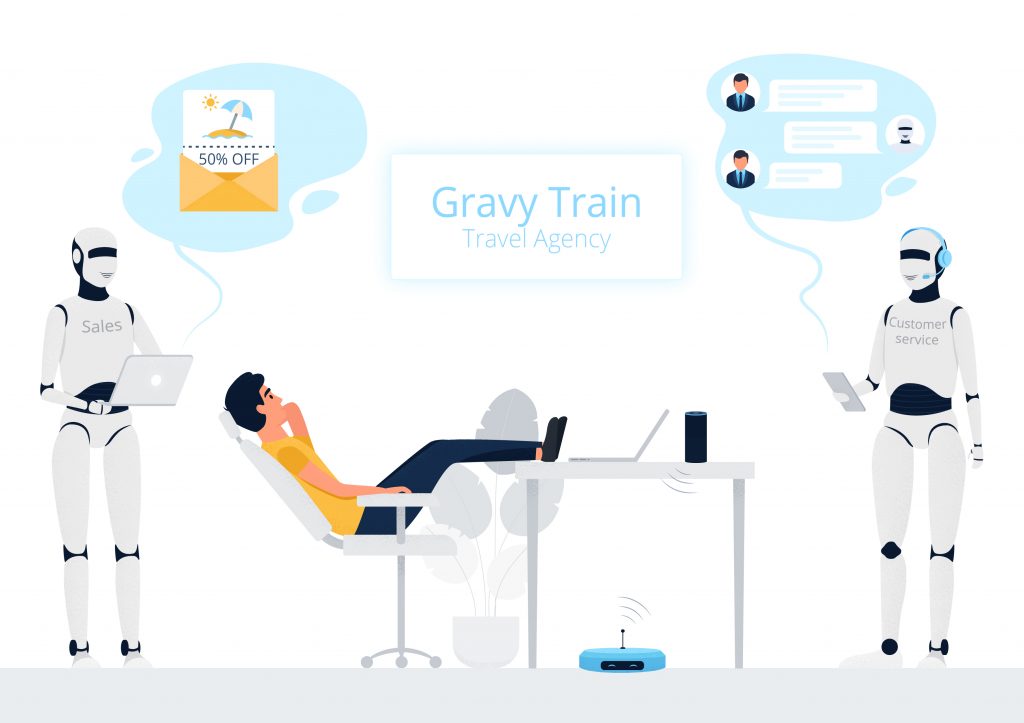
To Recap
When companies implement automation solutions properly, they can increase sales and brand awareness while saving time, effort, and money. Chatbots take on the burden of time-consuming, repetitive tasks. They make communication with customers simpler and easier, add value, and create better customer experiences. Such automation empowers human agents and streamlines the marketing, sales, and customer service experiences. The result is greater satisfaction on both sides of the conversation.
Bots and chats make it easier for people to buy the way they want to and when they want. From closing a garage door to a mortgage application, anything can be done faster and more conveniently with chatbots. They also offer a fun and interactive way to engage with brands.
Chatbots have quickly managed to increase revenues for 1–800-Flowers, eBay, Sephora, and other leaders. Their example inspires others to start leveraging chatbot technology. But with so many types of chatbots out there, it may be difficult to make the right choice. Start with research into your audience’s needs and preferences. Evaluate the communication channels to connect with the target groups best. If you need advice from professional chatbot developers — we’re always here to help!
Content created by our partner, Onix-systems.
 Home
Home